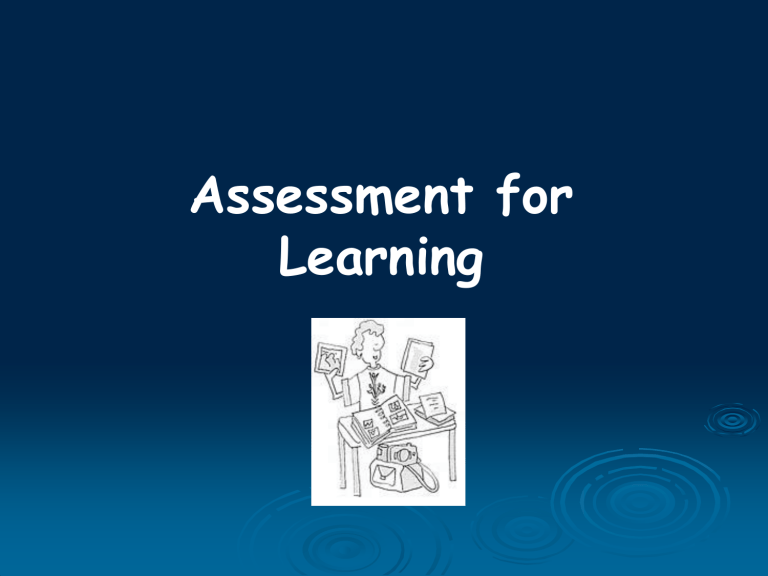AFL training

Assessment for
Learning
Objectives
To understand what is meant by assessment for learning
To understand why and how it could benefit us
To understand what it implies for day to day teaching
To develop practical examples and strategies for using assessment for learning in our schemes of work
What is Assessment for
Learning? (1)
It is formative in nature
It takes place ALL THE TIME in the classroom
Its purpose is to help pupils’ learning
It HAS to be used to inform planning
What is Assessment for
Learning? (2)
It is NOT assessment
OF learning, which tends to be summative, at the end of a unit of work, and enables the teacher to make
JUDGEMENTS about pupils’ performance
What is Assessment for
Learning? (3)
‘… all those activities undertaken by teachers,
and by their students in assessing themselves, which provide information to be used as feedback to modify the teaching and learning activities in which they are engaged.’
Black, P. and Wiliam, D. (1998)
What is Assessment for
Learning? (4)
‘Assessment for learning involves:
gathering and interpreting evidence about students’ learning; and learners and their
teachers using that evidence to decide where students are in their learning, where they are going and how to take the next steps.’
Assessment for Learning
is embedded in a view of teaching and learning of which it is an essential part;
involves sharing learning goals with pupils;
aims to help pupils to know and recognise the standards they are aiming for;
involves pupils in [peer and] self-assessment;
provides feedback which leads to pupils recognising their next steps and how to take them;
involves both teacher and pupils reviewing and reflecting on assessment data [information].
Assessment for learning: beyond the black box, Assessment Reform Group (1999)
•
•
•
•
Why should we use AFL?
Classes using A FL:-
All produce significant / substantial learning gains
The average gain across the classes would equate to a GCSE performance improvement of between 1 and 2 grades
Many show that AFL helps the lower attainers more than the rest and so reduces the spread of attainment whilst raising it overall
This could have a knock-on effect on behaviour and commitment
Information from ‘Inside the Black Box’ by Black & Wiliam
What does AFL imply for day to day teaching?
•
•
•
•
Some significant changes in classroom practice – BUT building on what we already do
Students HAVE to be actively involved
Results of a AFL have to be used to adjust teaching
Willingness to forego content to ensure understanding – “…’delivery’ & ‘coverage’ with poor understanding are pointless and even harmful” (B &W)
AFL in action
Watch the video clip.
As you do, fill in your observations on handout 1.1 – third column
Factors that contributed to the pupils learning on the video
Communicating the aims of the lesson clearly to pupils
Making assessment criteria clear and accessible to pupils
Longer wait time during questioning
Oral and written feedback
Pupils required to reflect on their learning using assessment criteria
Balance of self-, peer and teacher assessment
Pupils trained in how to behave cooperatively in group work
Feedback giving specific targets for improvement
Different media used to assess pupils so that some can demonstrate their understanding through means other than writing
Practical Strategies for AFL
1. five key features
•
•
•
•
•
Provide EFFECTIVE feedback to pupils
Actively involve pupils in their own learning
Adjust teaching to take account of assessment
Recognise that assessment has a profound influence on motivation & self-esteem – both crucial to learning
Provide ways for pupils to assess themselves and understand how
Practical Strategies for AFL
2. Five ideas
1.
2.
3.
4.
5.
Look at your existing assessments.
Consider how you prepare for them
AND feed back after them
Change questioning techniques
Use ‘checklists’ when setting work
Stop marking so much!
Use alternatives to ‘check learning’ – starters, plenaries etc.
The way forward?
Let’s do a quick audit
And then decide on what we should and can do for our department/ area….
![afl_mat[1]](http://s2.studylib.net/store/data/005387843_1-8371eaaba182de7da429cb4369cd28fc-300x300.png)






